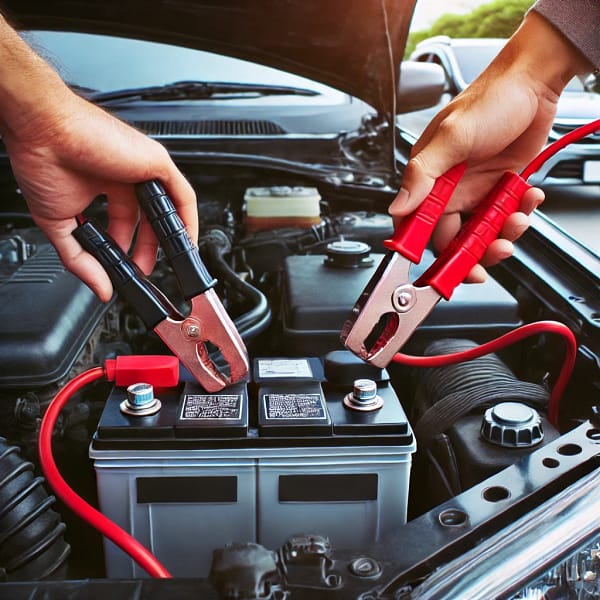Before starting the jump-start process, it’s essential to prioritize safety. Ensure both vehicles are parked close enough for the jumper cables to reach both batteries, but make sure they are not touching. Turn off both cars and engage the parking brakes. This setup helps prevent accidents during the process. It’s also essential to make sure you’re in a safe location away from traffic to avoid any additional risks.
Inspect both batteries for any signs of damage or leaks. If you notice any damage, do not attempt to jump-start the car, as it could be dangerous and potentially cause further damage to the vehicles or injury to yourself.
Connecting the Jumper Cables
Start by connecting one end of the red (positive) jumper cable to the positive terminal of the dead battery. This terminal is usually marked with a “+” symbol or is colored red. Next, connect the other end of the red cable to the positive terminal of the working battery. This setup creates a direct link between the two batteries, allowing the electrical current to flow.
Next, connect one end of the black (negative) jumper cable to the good battery’s negative terminal. For the other end of the black cable, find an unpainted metal surface on the engine block or frame of the car with the dead battery. This grounding point helps prevent sparks and safely completes the circuit.
Starting the Vehicles
Turn on the car’s engine with a good battery and let it run for a few minutes to charge the dead battery. This step is essential, as it stabilises the electrical current and provides enough charge to start the dead battery.
After a few minutes, try starting the car with the dead battery. If it doesn’t start immediately, wait a few more minutes and try again. If the car still doesn’t start, the battery may be too drained, or other underlying issues could prevent it from starting.
Disconnecting the Jumper Cables
Once the car with the dead battery runs, it’s time to remove the jumper cables safely. Start by disconnecting the black cable from the unpainted metal surface (ground) on the car with the dead battery. Then, remove the black cable from the good battery’s negative terminal. Next, disconnect the red cable from the positive terminal of the good battery. Finally, remove the red cable from the positive terminal of the previously dead battery. This sequence helps prevent any accidental sparks or electrical issues.
Post-Jump-Start Procedures
After successfully jump-starting the car, keep it running for at least 15–30 minutes. This allows the alternator to recharge the battery, ensuring it has enough power to start again in the future. Driving around is also an excellent way to charge the battery and confirm that everything is fully functional.
Following these steps, you can safely and effectively use jumper cables to jump-start a car with a dead battery. Always prioritize safety and check for any signs of damage before attempting to jump-start a vehicle.
Additional Tips
- Never let the jumper cable clamps touch each other or any metal part of the car during the process, as this could cause sparks or a short circuit.
- Always consult your vehivehicle’seowner’sual for any specific instructions or precautions related to jump-starting.
FAQs
Which jumper cable goes on first?
The red cable, which is the positive cable, should always be connected first. Start by attaching one end to the dead battery’s positive terminal, and then connect the other end to the positive terminal of the good battery. This helps prevent accidental short circuits and sparks.
How long should I leave jumper cables on a dead battery?
Once the car with the dead battery starts, leave the jumper cables connected for a few minutes to help charge the battery. Generally, 5–10 minutes is sufficient, but if the battery is severely drained, you might need to keep it on longer.
How do I apply jump leads?
Attach the red (positive) cable to the dead battery’s positive terminal first, then to the positive terminal of the good battery. Next, attach the black (negative) cable to the good battery’s negative terminal. Finally, connect the other end of the black cable to an unpainted metal surface on the car’s engine block with the dead battery.
What not to do when using jumper cables?
Avoid letting the jumper cable clamps touch each other while connected to the batteries, as this can cause dangerous sparks. Never connect the black (negative) cable directly to the dead battery’s negative terminal; instead, attach it to an unpainted metal surface on the engine block. Also, ensure both cars are turned off before connecting the cables.
Will jumper cables help a dead battery?
Yes, jumper cables can help start a car with a dead battery by connecting it to a charged battery. This provides the necessary power to start the engine. However, if the battery is too old or damaged, jumper cables might not be effective, and the battery may need to be replaced.
Continue your journey of learning with our latest posts! Click here to explore more on howtothings.net.
How to Lock fishing Reels on a Car Roof?
How To Clean Inside and Outside of your Car At home

